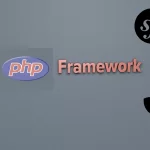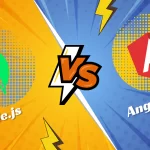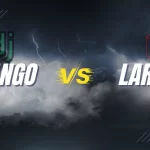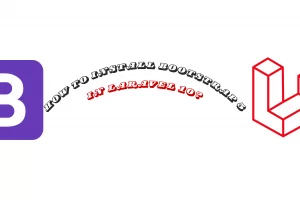Embarking on web development means navigating the choice between Django and Laravel. Each, with its unique strengths, beckons developers. In this comprehensive Django vs. Laravel comparison, we’ll unravel the features, advantages, and potential drawbacks of each framework, aiding your informed decision-making in the dynamic world of web development.
Django, rooted in Python, is a powerful, versatile framework with a “batteries-included” philosophy, streamlining development. Its emphasis on security and scalability suits complex, high-performance web applications. We’ll explore Django’s balance between convention and flexibility, offering a robust foundation with customization options.
Laravel, a PHP gem, is celebrated for elegance and expressiveness. Its clean syntax and features like eloquent ORM and Blade templating empower developers. Navigating Laravel’s ecosystem, we’ll uncover how its structure fosters an enjoyable coding experience. Laravel is more than code; it’s a testament to PHP’s evolution in modern web development. Together, we’ll dissect Laravel’s attributes and assess its suitability for various project scenarios.
Django: The Pythonic Powerhouse
Django, a Pythonic powerhouse, stands tall as a robust and versatile framework in web development. With its “batteries-included” philosophy, Django offers a comprehensive set of built-in features that streamline the development process. This approach not only enhances efficiency but also ensures a secure and scalable environment for building complex web applications.
At its core, Django embraces the simplicity and elegance of the Python language, making it accessible to developers of varying skill levels. The framework’s modular design allows developers to leverage pre-built components while providing the flexibility to tailor applications to specific needs. Django’s commitment to convention over configuration promotes a standardized and organized approach to development, fostering maintainability and collaboration within development teams.
As we navigate through the Pythonic landscape of Django, we’ll explore its key attributes, such as its ORM (Object-Relational Mapping) system for seamless database interactions, templating engine for dynamic content rendering, and a built-in admin panel for efficient content management. Django’s emphasis on DRY (Don’t Repeat Yourself) principles and its adherence to the MVC (Model-View-Controller) architectural pattern contribute to the framework’s reputation as a powerhouse for web development in the Python ecosystem.
Laravel: The PHP Artisan
Laravel, often hailed as the PHP Artisan, represents a paradigm of elegance and expressiveness within the realm of web development. This PHP framework has not only redefined the coding experience but has also garnered acclaim for its clean and developer-friendly syntax. Laravel’s commitment to providing a delightful and intuitive environment for developers is encapsulated in its title—the PHP Artisan.
The framework’s use of the term “Artisan” reflects its emphasis on craftsmanship and the mastery of the development process. Laravel’s syntax, akin to an artisan’s craftsmanship, is both refined and efficient. It allows developers to craft intricate web applications with a sense of artistry, balancing simplicity with powerful features. Laravel’s commitment to the PHP language is evident in its role as a torchbearer for modern PHP web development practices.
In our exploration of Laravel, we’ll delve into key features such as the eloquent ORM (Object-Relational Mapping) for seamless database interactions, the expressive Blade templating engine, and the Artisan command-line tool that streamlines various development tasks. Laravel’s appeal extends beyond its functional capabilities; it embodies a commitment to creating a framework that not only meets technical requirements but also elevates the coding experience to an art form.
Also Read: Top 10 Backend Development Companies in USA 2024
Django vs. Laravel: The Showdown
1. Django vs. Laravel: Learning Curve and Documentation
Embarking on web development often begins with choosing a framework. In this comparison, we explore how Django and Laravel facilitate the learning process and provide documentation support.
Django’s Learning Experience:
Django, rooted in Python, offers a gentle learning curve. Its documentation is comprehensive, providing clear guidance through examples and tutorials. Python’s readability enhances the learning process, making Django accessible to developers at various skill levels.Laravel’s Intuitive Onboarding:
Laravel, in the PHP domain, boasts an intuitive syntax for a smooth onboarding experience. The well-organized documentation serves as a roadmap, covering basics and advanced features. Laravel’s supportive community adds value, offering forums and resources for developers seeking assistance.Choosing the Path:
In the Django vs. Laravel debate, the learning curve and documentation are pivotal factors. Django suits those new to web development, with its gentle approach and Python’s readability. Laravel, with its intuitive syntax and robust documentation, appeals to PHP developers seeking an expressive framework.
Consider your team’s preferences as you venture into web development, guided by the clear documentation provided by Django and Laravel.
2. Django vs. Laravel: Community and Ecosystem
In the vibrant world of web development, a framework’s community and ecosystem play a pivotal role in shaping its growth and support structure. Let’s explore how Django and Laravel fare in this crucial aspect.
Django’s Thriving Community:
Django boasts a large and thriving community that contributes to its strength. With a diverse pool of developers, the community ensures extensive support and a wealth of third-party packages. This collaborative spirit enhances Django’s ecosystem, providing solutions to various challenges and fostering continuous improvement.Laravel’s Enthusiastic Growth:
While younger than Django, Laravel has experienced rapid growth and cultivated an enthusiastic community. This community, driven by a shared passion for Laravel’s elegance, actively contributes to its expansion. Laravel’s ecosystem benefits from this collective effort, with a growing repository of packages and a supportive network of developers.Assessing the Impact:
In the Django vs. Laravel comparison, community support is a significant factor. Django’s established community offers stability and a rich repository of resources. Meanwhile, Laravel’s dynamic and enthusiastic community brings fresh perspectives and rapid advancements.
As you navigate the web development landscape, consider the strength and dynamics of the community behind Django and Laravel. Both frameworks offer unique opportunities for collaboration, ensuring that developers can tap into a supportive network as they bring their projects to life.
3. Django vs. Laravel: Performance Unveiled
Performance is a critical consideration in the Django vs. Laravel debate, as it directly impacts the responsiveness and scalability of web applications. Let’s delve into how these frameworks measure up in terms of speed and efficiency.
Django’s Commendable Performance:
Django, when optimized, delivers commendable performance. Its adherence to best practices and optimization techniques ensures efficient execution. While Django may initially seem conservative in terms of speed, its performance shines when developers implement optimizations tailored to their specific project needs.Laravel’s Swift Execution:
Laravel, known for its elegant syntax, excels in speed and performance. The framework’s design prioritizes efficiency, making it a swift performer. Laravel’s Blade templating engine and Eloquent ORM contribute to its overall speed, allowing developers to create responsive and high-performance web applications.Deciding on Speed:
In the performance realm of Django vs. Laravel, the choice depends on the specific requirements of your project. Django’s performance is solid when optimized, making it suitable for a wide range of applications. Laravel, with its emphasis on speed, is an excellent choice for projects where rapid execution is paramount.
Consider the nature of your web application, scalability needs, and development preferences as you weigh the performance characteristics of Django and Laravel. Both frameworks offer robust performance, and the optimal choice depends on the unique demands of your project.
Also Read: How to Outsource node.js Development Services in the USA
4. Django vs. Laravel: Unraveling Flexibility and Customization
Flexibility and customization are pivotal in choosing a web development framework. In the Django vs. Laravel comparison, let’s explore how each framework approaches adaptability to meet diverse project needs.
Django’s Modular Versatility:
Django, with its “batteries-included” philosophy, might seem less flexible at first glance. However, beneath its structured exterior lies a modular design that allows developers to cherry-pick components. This approach strikes a balance between convention and flexibility, providing a robust foundation while accommodating customization based on project requirements.Laravel’s Elegant Customization:
Laravel, celebrated for its elegant syntax, offers flexibility and customization options. Laravel’s clean and expressive codebase empowers developers to tailor applications with ease. The framework’s flexibility is evident in its Blade templating engine, eloquent ORM, and artisan commands, providing a canvas for developers to craft applications precisely to their specifications.Navigating the Balance:
In the realm of Django vs. Laravel, the balance between convention and customization is crucial. Django’s modularity allows developers to adapt the framework to their needs, while Laravel’s elegant syntax and expressive features make customization a delightful experience. Consider the nature and scope of your project as you choose between the structured versatility of Django and the expressive customization of Laravel. Both frameworks offer a robust foundation with room for adaptation, ensuring your web development journey is tailored to your project’s unique requirements.
Real-World Impact
The true test of a web development framework lies in its real-world applications. Let’s explore how Django and Laravel have made their mark by powering high-traffic websites and applications.
Django’s Scalability:
Django has proven its mettle by contributing to the development of high-traffic platforms. Instagram, a social media giant, leverages Django’s scalability to handle a vast user base seamlessly. Pinterest, another content-rich platform, showcases Django’s ability to manage and deliver diverse content efficiently. These real-world applications highlight Django’s reliability and suitability for projects requiring robust scalability.Laravel’s Elegance in Action:
Laravel, with its clean codebase and expressive features, has left an imprint on various real-world applications. Deltanet Travel, a platform in the travel industry, utilizes Laravel’s elegance to create a seamless user experience. Toyota Hall of Fame, an interactive marketing campaign, stands as a testament to Laravel’s capability to craft engaging and dynamic web applications. Laravel’s real-world applications underscore its versatility and effectiveness in diverse industries.Choosing Based on Track Record:
In the Django vs. Laravel debate, real-world applications serve as tangible evidence of a framework’s capabilities. Django’s contribution to social media behemoth Instagram and content-centric Pinterest showcases its scalability. Laravel’s involvement in travel and interactive marketing demonstrates its elegance and adaptability. Consider the track record of these frameworks in industries similar to yours as you make an informed decision on whether Django’s scalability or Laravel’s elegance aligns better with your project’s objectives.
Security Measures:
Ensuring the security of web applications is paramount in the ever-evolving digital landscape. Django and Laravel, as robust frameworks, prioritize safeguarding applications through distinct security measures.
Django’s Security Embrace:
Django places a high premium on security, incorporating features like built-in protection against common vulnerabilities. Its emphasis on the principle of least privilege and secure-by-default settings fortifies web applications from potential threats. Django’s comprehensive documentation guides developers in implementing secure coding practices, promoting a proactive approach to security.Laravel’s Protective Veil:
Laravel, too, champions security with features such as hashed password storage and a robust ORM layer that helps prevent SQL injection attacks. Laravel’s integrated tools like Laravel Sanctum for API authentication and Laravel Passport for OAuth2 provide developers with powerful security solutions. The framework’s commitment to ensuring secure defaults and guiding developers in secure coding practices enhances the overall resilience of Laravel-powered applications.Weighing Security Factors:
In the Django vs. Laravel deliberation, security considerations are pivotal. Django’s secure-by-default approach and comprehensive documentation instill confidence in developers. Laravel, with its array of security features and protective tools, offers a robust defense against potential threats. As you assess security measures, consider the specific needs of your project and how each framework aligns with your commitment to building resilient and secure web applications.
Also Read: How to install Laravel for Visual Studio Code
Conclusion
Concluding our exploration of Django and Laravel, the choice between these frameworks is a pivotal decision in the dynamic landscape of web development. Both Django and Laravel exhibit distinct strengths, each contributing to a unique developer experience.
Django, recognized as a Pythonic powerhouse, stands out with its structured approach and modular design. Its “batteries-included” philosophy offers a comprehensive set of features, while the framework’s modularity allows developers to customize solutions according to specific needs. Real-world applications like Instagram and Pinterest underscore Django’s scalability and effectiveness in handling high-traffic platforms.
On the other hand, Laravel, often referred to as the PHP Artisan, captivates with its elegant syntax, expressive features, and swift performance. Real-world applications such as Deltanet Travel and Toyota Hall of Fame showcase Laravel’s versatility across diverse industries. The framework’s active and enthusiastic community contributes to its dynamic growth and adaptability.
Ultimately, the choice between Django and Laravel depends on project requirements, team expertise, and the preferred development philosophy. Django offers a structured and scalable path rooted in Python’s simplicity, while Laravel provides an expressive and adaptable journey defined by elegant code. Whether drawn to the Pythonic power of Django or the PHP Artisan craftsmanship of Laravel, both frameworks stand as pillars in the ever-evolving landscape of web development.















